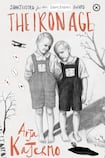
‘The shrapnel that had gone into Father’s legs, in 1944 in the painful retreat when the war was lost, had somehow worked its way into his children. Each one of us carried a shard of that iron in our hearts. We would never be at peace.”
Although it is set in postwar Scandinavia, Arja Kajermo's debut novel, The Iron Age, could as easily be the story of a poverty-stricken family in 20th-century Ireland.
There are former soldiers turned disgruntled father figures, a la John McGahern, the displaced people of Hugo Hamilton’s novels and the “ordinary miserable childhoods” of Frank McCourt’s – although a vicious minus-30 climate makes the rain-sodden streets of Limerick a virtual paradise in comparison.
In the same way that the hardship and bleak humour of Russian theatre resonate with Irish audiences, Russia's neighbour Finland reads like a home away from home. Cold climates and cold hearts are at the centre of The Iron Age, a charming coming-of-age novel told from the perspective of a young girl.
Marooned on her grandmother's farm with a jaded mother, a violent father and brothers who ignore her, "the girl" finds solace in her imagination. Myth and fairytale elements feature throughout the book, from the story of the two Finnish spitz pups, Nalle and Nille, told in an allegorical style, to the dangers of turning away a noita-akka from the doorstep, and the whimsical tale of how people in Finland get depressed if pine trees grow too close to their homes.
Semiautobiographical
Kajermo uses fable effectively to bring her semiautobiographical story to life and to give brightness to some of the grimmer elements. A laconic humour underpins the action. The story of the spitz pup Nille has a happy ending: “The runt had turned into one of father’s triumphs. And there were not many of those.”
Things fare less well for the children themselves, who have to ski to school in freezing conditions and stay quiet at home for fear of riling their father. They are not even allowed to celebrate their birthdays: “After all, a child has achieved nothing except being born and any fool could do that.” Instead the harsh farm landscape is a place where adults constantly moan about war and loss: “Every day was an anniversary of someone’s death.”
At 128 pages, some of which are given over to captivating illustrations by the author's niece Susanna Kajermo-Torner, there is a slight feel to the novel, which is compounded by extremely short chapters. It is less a criticism than a reflection of wanting to hear more from the wily young narrator as she takes on her father's temper and a relocation to Sweden alarmingly astutely for a six-year-old.
From Finland, Kajermo lived in Sweden as a child and came to Ireland as an au pair in the 1970s. A cartoonist by trade, she has contributed to the feminist publisher Attic Press, the Sunday Tribune and The Irish Times, among others.
Kajermo writes in short but affecting scenes, perhaps indicative of the fact that the book grew out of notes for an intended graphic novel. Its first incarnation resulted in a finalist nomination for the 2014 Davy Byrnes Short Story Award, which the judges praised as "a memorable chronicle of a family's struggle during a less well-known period in history".
This carries through to the novel as the author brings her unusual worlds to life in choice details: “The sun never set on our Arctic idyll in the summer. The ‘nightless nights’ were bright and relentless.”
Readers learn about a nation still suffering from civil war in 1918, the Winter War in 1939, and the Continuation War from 1940 to 1944. The text is peppered with native words: the neighbourly witch, noita-akka; fiksu, a smartly dressed man; or, most poignantly, following the family's move to Sweden, unmikko, people who can speak only their native tongue and not the one around them.
The miserable conditions of postwar Finland, where there is “lots of work for strapping girls of thirteen and fourteen”, contrast with those in Sweden, where rich people have several phone numbers in the book, including those for their household staff.
Dislocation
While her father refers to Sweden as “the Future”, the dislocation of the immigrant is felt keenly by his daughter. As his temper gets worse she stops speaking: “I realised I was safe inside, looking out at a very angry man. And I was not afraid.”
The quashing of female voices is a recurring theme, with Kajermo particularly strong on the gender inequality and sexism of the era. "A brave woman?" says the girl's father. "It was against nature – like a bearded lady." Yet the strongest characters in The Iron Age are all female, from the shrewd grandmother to the tireless mother to the girl herself, who views silence as a refuge and a position from which she can observe the steely world around her.












